This pub is closed permanently. Your nearest Wetherspoon pub: The Blue Boar
The writer George Orwell famously described his ideal pub in a newspaper article. The fictitious pub was called ‘Moon Under Water’ – which is why several Wetherspoon pubs have ‘moon’ in their name. This one is part of a parade built in the late 1950s, when Basildon New Town was taking shape. Since then, the occupants of the premises have included a baker, a hairdresser and two butchers.
Prints and text about Moat Farm.
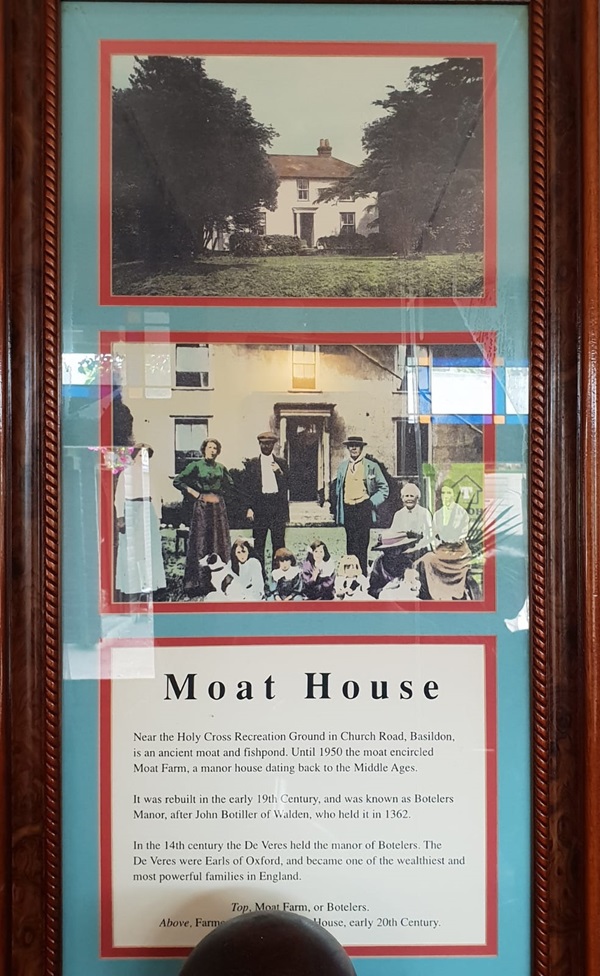
The text reads: Near the Holy Cross Recreation Ground in Church Road, Basildon, is an ancient moat and fishpond. Until 1950 the moat encircled Moat Farm, a manor house dating back to the Middle Ages.
It was rebuilt in the early 19th century, and was known as Botelers Manor, after John Botiller of Walden, who held it in 1362.
In the 14th century the De Veres held the manor of Botelers. The De Veres were Earls of Oxford, and became one of the wealthiest and most powerful families in England.
Top: Moat Farm, or Botelers.
A print and text about invasions in Basildon.
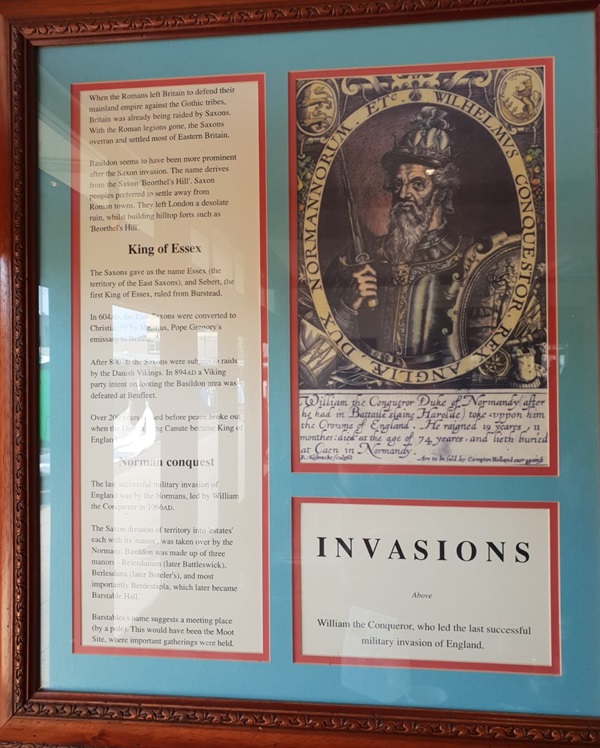
The text reads: When the Romans left Britain to defend their mainland empire against the Gothic tribes, Britain was already being raided by Saxons. With the Roman legions gone, the Saxons overran and settled most of Eastern Britain.
Basildon seems to have been more prominent after the Saxon invasion. The name derives from the Saxon ‘Beorthel’s Hill’. Saxon peoples preferred to settle away from Roman towns. They left London a desolate ruin, whilst building hilltop forts such as ‘Beorthel’s Hill’.
The Saxons gave us the name Essex (the territory of the East Saxons), and Sebert, the first King of Essex, ruled from Burstead.
In 604AD, the East Saxons were converted to Christianity by Mellius. Pope Gregory’s emissary to Britain.
After 800AD the Saxons were subject to raids by the Danish Vikings. In 892AD a Viking party intent on looting the Basildon area was defeated at Benfleet.
Over 200 years passed before peace broke out when the Danish King Canute became King of England.
The last successful military invasion of England was by the Normans, led by William the Conqueror in 1066AD.
The Saxon division of territory into estates each with it manor, was taken over by the Normans. Basildon was made up of three manors. Belesdunam (later Battleswick), Berlesduna (later Boteler’s), and most importantly Berdestapla, which later became Barstable Hall.
Barstable’s name suggests a meeting place (by a pole). This would have been the Moot Site, where important gatherings were held.
Above: William the Conqueror, who led the last successful military invasion of England.
A print and text about Barstable Cottage and Barstable Hall.
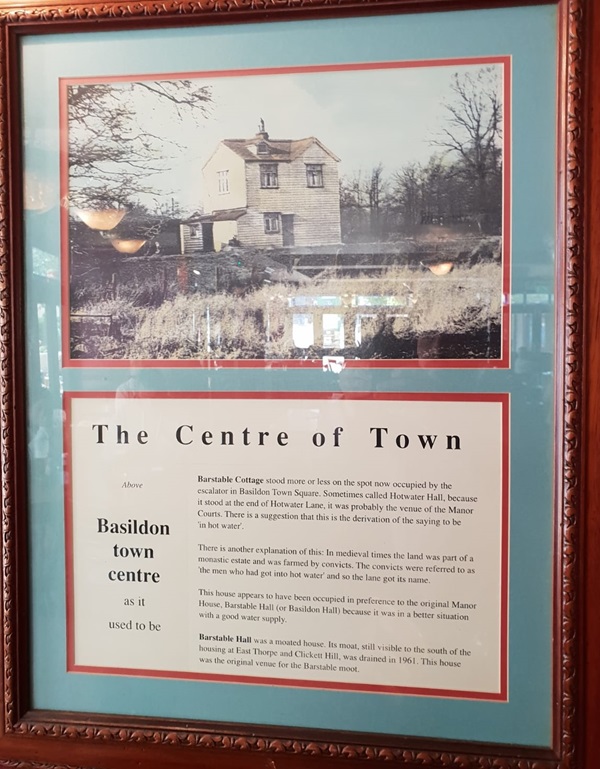
The text reads: Barstable Cottage stood more or less on the spot now occupied by the escalator in Basildon Town Square. Sometimes called Hotwater Hall, because it stood at the end of Hotwater Lane, it was probably the venue of the Manor Courts. There is a suggestion that this is the derivation of the saying to be ‘in hot water’.
There is another explanation of this: In medieval times the land was part of a monastic estate and was farmed by convicts. The convicts were referred to as ‘the men who had got into hot water’ and so the lane got its name.
This house appears to have been occupied in preference to the original Manor House, Barstable Hall (or Basildon Hall) because it was in a better situation with a good water supply.
Barstable Hall was a moated house. Its moat, still visible to the south of the housing at East Thorpe and Clickett Hill, was drained in 1961. This house was the original venue for the Barstable moot.
Above: Basildon town centre as it used to be.
A print and text about blacksmith’s.
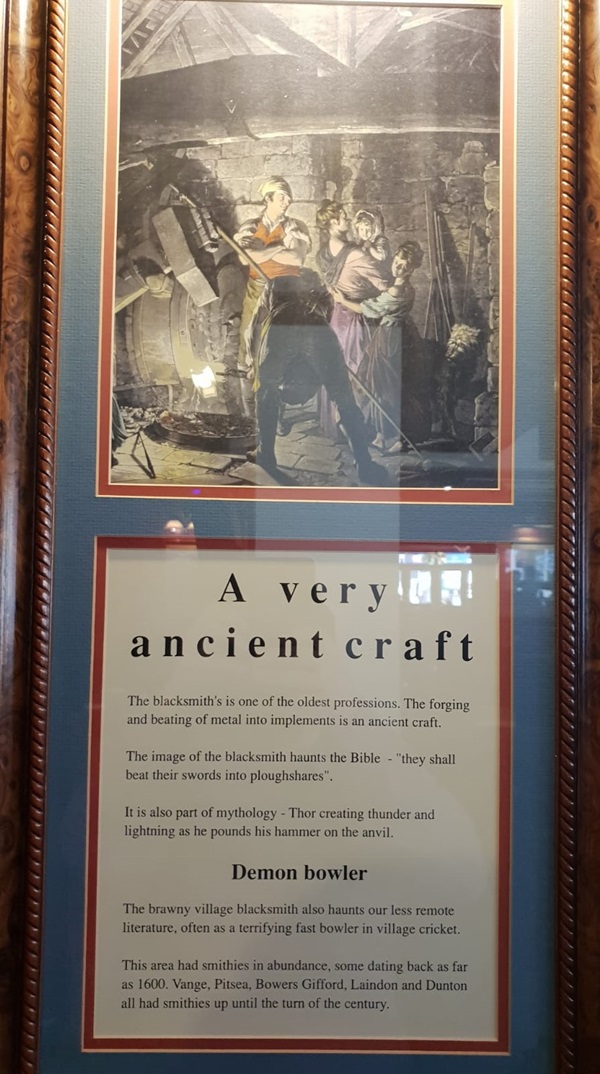
The text reads: The blacksmith’s is one of the oldest professions. The forging and beating of metal into implements is an ancient craft.
The image of the blacksmith haunts the Bible – “they shall beat their swords into ploughshares”.
It is also part of mythology – Thor creating thunder and lightning as he pounds his hammer on the anvil.
The brawny village blacksmith also haunts our less remote literature, often as a terrifying fast bowler in village cricket.
This area had smithies in abundance, some dating back as far as 1600. Vange, Pitsea, Bowers Gifford, Laindon and Dunton all had smithies up until the turn of the century.
Prints and text about building the English fleet.
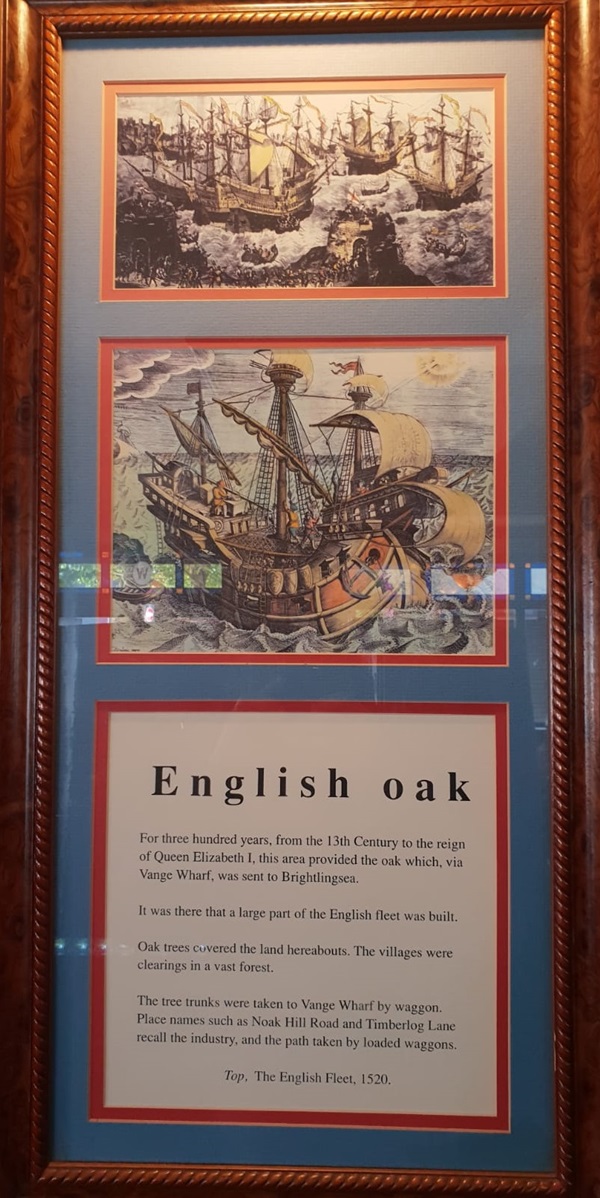
The text reads: For three hundred years, from the 13th century to the reign of Queen Elizabeth I, this area provided the oak which, via Wange Wharf, was sent to Brightlingsea.
It was there that a large part of the English fleet was built.
Oak trees covered the land hereabouts. The villages were clearings in a vast forest.
The tree trunks were taken to Vange Wharf by waggon. Place names such as Noak Hill Road and Timberlog Lane recall the industry, and the path taken by loaded waggons.
Top: The English Fleet, 1520.
Prints and text about smuggling.
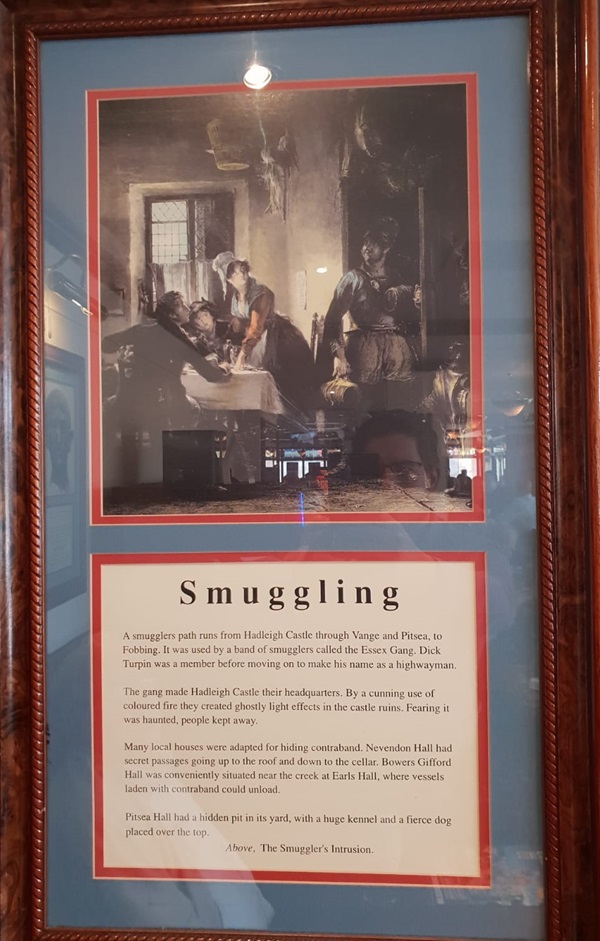
The text reads: A smugglers path runs from Hadleigh Castle through Vange and Pitsea, to Fobbing. It was used by a band of smugglers called the Essex Gang. Dick Turpin was a member before moving on to make his name as a highwayman.
The gang made Hadleigh Castle their headquarters. By a cunning use of coloured fire they created ghostly light effects in the castle ruins. Fearing it was haunted, people kept away.
Many local houses were adapted for hiding contraband. Nevendon Hall had secret passages going up to the roof and down to the cellar. Bowers Gifford Hall was conveniently situated near the creek at Earls Hall, where vessels laden with contraband could unload.
Pitsea Hall had hidden pit in its yard, with a huge kennel and a fierce dog placed over the top.
Above: The Smuggler’s Intrusion.
Prints and text about the new town.
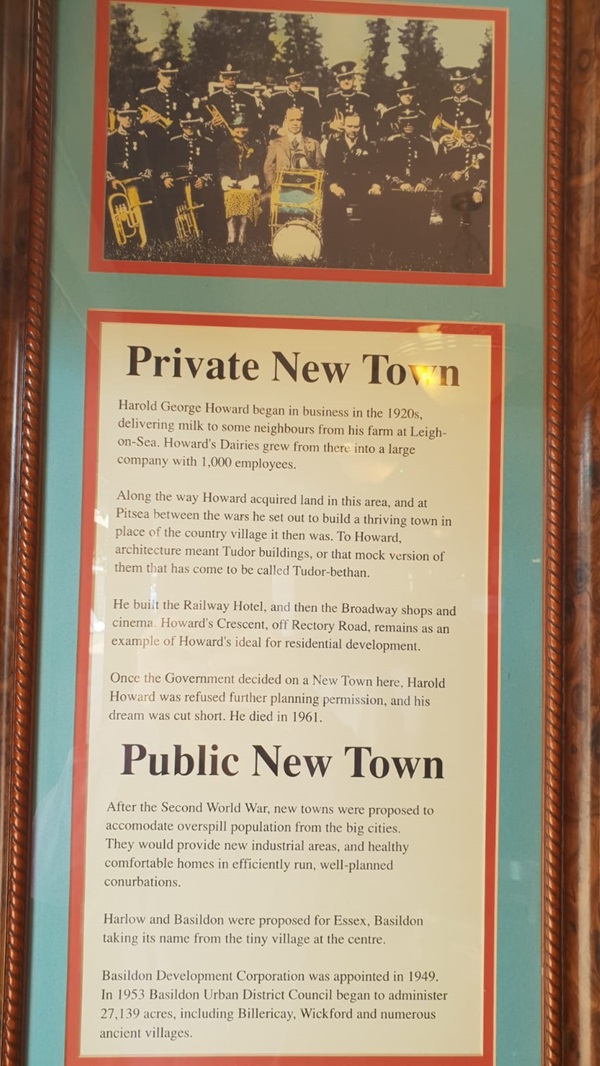
The text reads: Private New Town
Harold George Howard began in business in the 1920s, delivering milk to some neighbours from his farm at Leigh-on-Sea. Howard’s Dairies grew from there into a large company with 1,000 employees.
Along the way Howard acquired land in this area, and at Pitsea between the wards he set out to build a thriving town in place of the country village it then way. To Howard, architecture meant Tudor buildings, or that mock version of them that has come to be called Tudor-bethan.
He built the Railway Hotel, and then the Broadway shops and cinema. Howard’s Crescent, off Rectory Road, remains as an example of Howard’s ideal for residential development.
Once the government decided on a New Town here. Harold Howard was refused further planning permission, and his dream was cut short. He died in 1961.
Public New Town
After the Second World War, new towns were proposed to accommodate overspill population from the big cities. They would provide new industrial areas, and healthy comfortable homes in efficiently run, well-planned conurbations.
Harlow and Basildon were proposed for Essex, Basildon taking its name from the tiny village at the centre.
Basildon Development Corporation was appointed in 1949. In 1953 Basildon Urban District Council began to administer 27,139 acres, including Billericay, Wickford and numerous ancient villages.
External photograph of the building – main entrance.
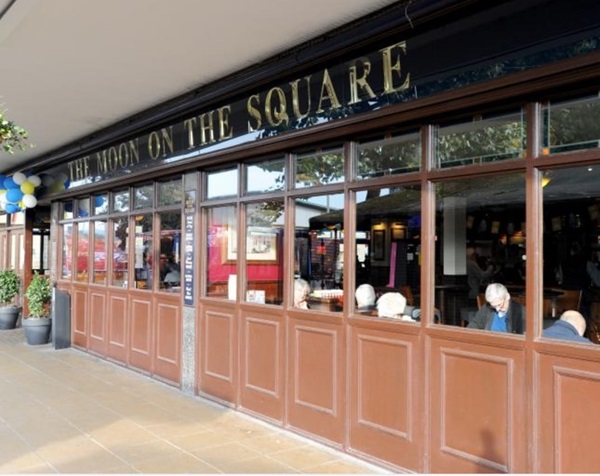
If you have information on the history of this pub, then we’d like you to share it with us. Please e-mail all information to: pubhistories@jdwetherspoon.co.uk